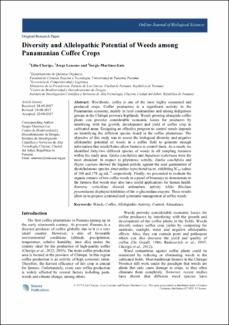| dc.contributor.author | Cherigo, Lilia | |
| dc.contributor.author | Lezcano, Jorge | |
| dc.contributor.author | Martínez-Luis | |
| dc.date.accessioned | 2020-07-18T21:01:19Z | |
| dc.date.available | 2020-07-18T21:01:19Z | |
| dc.date.issued | 2018-08-22 | |
| dc.identifier.other | DOI: 10.3844/ojbsci.2017.232.239 | |
| dc.identifier.uri | http://repositorio-indicasat.org.pa/handle/123456789/207 | |
| dc.description | Worldwide, coffee is one of the most highly consumed and produced crops. Coffee production is a significant activity in the Panamanian economy, mainly in rural communities and among indigenous groups in the Chiriquí province highlands. Weeds growing alongside coffee plants can provoke considerable economic losses for producers by interfering with the growth, development and yield of coffee crop in cultivated areas. Designing an effective program to control weeds depends on identifying the different species found in the coffee plantations. The objective of this study was to assess the biological diversity and negative allelopathic potential of weeds in a coffee field to generate enough information that would better allow farmers to control them. As a result, we identified forty-two different species of weeds in all sampling transects within the study area. Emilia sonchifolia and Impatiens walleriana were the most abundant. In respect to phytotoxic activity, Emilia sonchifolia and Hyptis capitata showed the highest activity against the seed germination of dicotyledonous species Amaranthus hypochondriacus, exhibiting IC50 values of 160 and 178 µg mL−1 , respectively. Finally, we proceeded to evaluate the organic extracts of two coffee weeds in a panel of bioassays to demonstrate to the farmers that weeds may also have useful applications for human health. Borreria verticillata showed antimalaric activity while Blechum pyramidatum displayed inhibition of the α-glucosidase enzyme. These results allow us to propose a rational and systematic management of coffee weeds | en_US |
| dc.description.abstract | Worldwide, coffee is one of the most highly consumed and produced crops. Coffee production is a significant activity in the Panamanian economy, mainly in rural communities and among indigenous groups in the Chiriquí province highlands. Weeds growing alongside coffee plants can provoke considerable economic losses for producers by interfering with the growth, development and yield of coffee crop in cultivated areas. Designing an effective program to control weeds depends on identifying the different species found in the coffee plantations. The objective of this study was to assess the biological diversity and negative allelopathic potential of weeds in a coffee field to generate enough information that would better allow farmers to control them. As a result, we identified forty-two different species of weeds in all sampling transects within the study area. Emilia sonchifolia and Impatiens walleriana were the most abundant. In respect to phytotoxic activity, Emilia sonchifolia and Hyptis capitata showed the highest activity against the seed germination of dicotyledonous species Amaranthus hypochondriacus, exhibiting IC50 values of 160 and 178 µg mL−1 , respectively. Finally, we proceeded to evaluate the organic extracts of two coffee weeds in a panel of bioassays to demonstrate to the farmers that weeds may also have useful applications for human health. Borreria verticillata showed antimalaric activity while Blechum pyramidatum displayed inhibition of the α-glucosidase enzyme. These results allow us to propose a rational and systematic management of coffee weeds | en_US |
| dc.format | application/pdf | |
| dc.format | https://creativecommons.org/licenses/by/4.0/deed.es | |
| dc.language.iso | eng | en_US |
| dc.rights | Info:eu-repo/semantics/openAccess | |
| dc.subject | Weeds | en_US |
| dc.subject | Coffee | en_US |
| dc.subject | Allelopathic Activity | en_US |
| dc.subject | Control | en_US |
| dc.subject | Abundance | en_US |
| dc.title | Diversity and Allelopathic Potential of Weeds among Panamanian Coffee Crops | en_US |
| dc.type | info:eu-repo/semantics/article | en_US |
| dc.type | Info:eu-repo/semantics/publishedversion | |

